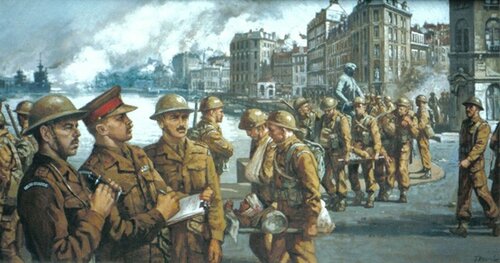Auction: 21002 - Orders, Decorations and Medals
Lot: 280
'I wish to express my admiration of the manner in which the Destroyers attached to the Dover Command carried out the difficult operation of evacuating the troops from Boulogne both in the face of heavy air attack and point-blank fire from guns, machine-guns and snipers. The handling of their ships and their armaments and the bearing of the ships' companies was beyond all praise. The following received from the CIGS [Chief of the Imperial General Staff] - Army's thanks to your people for last night's magnificent effort at Boulogne.'
A congratulatory message from the Vice-Admiral Destroyers, Dover, dated 24 May 1940, the recipients including the ship's company of H.M.S. Vimiera.
The Royal Navy L.S. & G.C. Medal awarded to Leading Steward R. L. R. Young, Royal Navy, a witness to the evacuation of numerous guardsmen from Boulogne in the destroyer H.M.S. Vimiera in May 1940
Royal Navy L.S. & G.C., G.VI.R., 1st issue (L. 14573 R. L. R. Young, L. Std., H.M.S. Vimiera), good very fine
Ronald Lionel Ralph Young was born in Bournemouth, Hampshire on 24 August 1907 and entered the Royal Navy as a Boy Servant in September 1923.
Advanced to Leading Steward in December 1939, he joined the ship's company of the destroyer H.M.S. Vimiera in the following month and quickly saw action off France in May 1940.
Boulogne: The other Dunkirk
The dramatic events played out at Boulogne on 23-24 May 1940 are well-recorded, but perhaps most impressive of all was Vimiera's daring return to the port after Dover Command had advised that further evacuation was considered 'impracticable'.
She arrived at the beleaguered port at 0140 hours on the 24th and berthed on the unprotected north-east side of the railway jetty [Gare Maritime], starboard side in. This left the ship fully exposed to the shore batteries on the northern ridge, but with a straight run down the channel in case it became necessary to leave abruptly. The silence in the town was eerie, the only noise being from a burning lorry a few yards away across the channel. At 0245, when no more men could be accommodated due to lack of space, Vimiera left the harbour with 1,400 men, making a total of close to 2,000 troops brought home from Boulogne. She returned to Dover at 0335 as dawn was breaking.
The following extract, taken from an article written by Major-General G. L. Verney, D.S.O., M.V.O. - for the Irish Guards Journal in 1957 - serves as a stirring tribute to the fine work carried out by Vimiera and eight other destroyers in the evacuation of Boulogne:
'There was no finer Naval enterprise during the late war than the evacuation from Boulogne by nine Destroyers, under close-range enemy fire, of the 2nd Battalions of the Irish and Welsh Guards and Headquarters, 20th Guards Brigade after a desperate 48 hours' defence of the port. With German artillery on the high ground less than a mile away, with enemy tanks on the quay on one side of the harbour, mortars, machine-guns and infantry in the houses and snipers on the roofs, the Destroyers came in two at a time - for the basin was too narrow for more - and took on board, first wounded and stragglers from the B.E.F. and Allied refugees, and then as many men of the two battalions as had been able to fight their way back through the town when the order for evacuation arrived.
Guardsmen, with seamen and marines of the demolition parties, fought as units together and held off the Germans for several hours while thousands of men were embarked and taken across the Channel, the task being made harder by numerous intense air attacks during which man bombs fell into the water so close to the ships that it seemed they could not survive. The accurate gunnery of the Navy excited the admiration of all; one enemy tank was sent spinning across the quay; snipers were blown off roofs; in one ship the mounting of a gun was blown away, but the gun was supported on the shoulders of some of its crew and continued firing.'
Fine work indeed.
Young was still serving in Vimiera on being awarded his L.S. & G.C. Medal and remained similarly employed until September 1940.
Subject to 20% VAT on Buyer’s Premium. For more information please view Terms and Conditions for Buyers.
Sold for
£210
Starting price
£50









